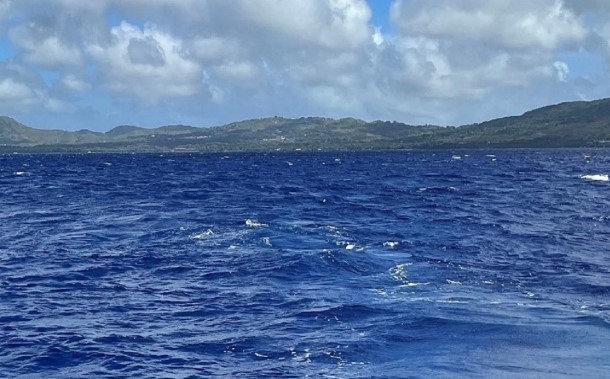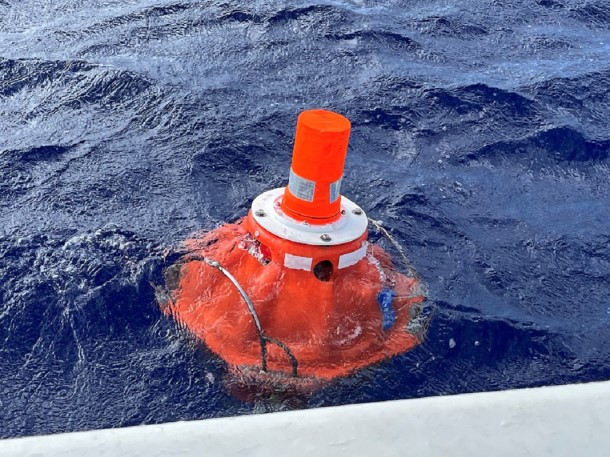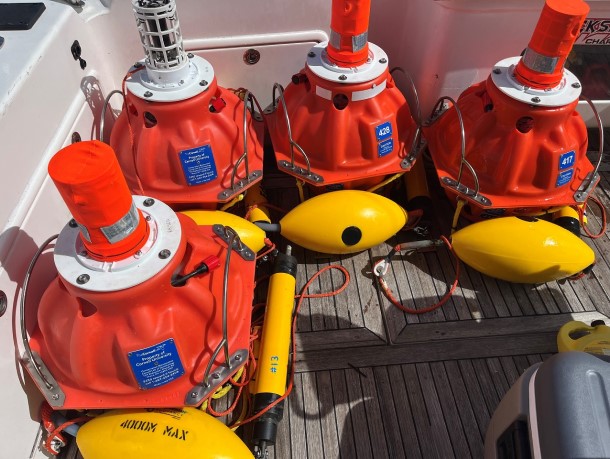Passive Acoustic Monitoring off the coast of Guam
Posted on December 14, 2022
Last week Navy biologists and collaborating scientists from the K. Lisa Yang Center for Conservation Bioacoustics at Cornell University, contracted through HDR, retrieved and re-deployed passive acoustic monitoring (PAM) devices off the coast of Guam.
Passive acoustic monitoring devices were deployed off the coast of Guam.
Marine mammals are dependent upon underwater sound for a variety of activities including communication, navigation, and foraging. For this reason, researchers often use PAM as a tool to “eavesdrop” on marine mammals and monitor various sounds beneath the water. Using various analysis methods, scientists may be able to determine the sources of specific sound, as well as the direction and distance from which the sound originates. PAM is, therefore, an excellent tool to increase the Navy’s understanding of the presence and distribution of marine mammals in areas of interest.
In May 2022 Cornell University researchers funded by the US Pacific Fleet, successfully deployed an array of PAM devices at select locations off the coast of Guam and for the last six months these devices have been recording the soundscape of the area. Last week devices were retrieved in order to retrieve the archived data and additional devices were deployed.
This research seeks to gather data that will determine what species of marine mammals (with a focus on beaked whales) are present within certain areas of the Mariana Island Training and Testing study area. More specifically, the Navy plans to examine beaked whale spatial and temporal patterns with the hopes of potentially gaining a better understanding of species’ behavior and population density.
The PAM devices developed by the Cornell Lab of Ornithology, called Rockhoppers (yes, named after the adorable Rockhopper penguin), are technology complete with a hydrophone (an underwater microphone), electronics (battery, recording unit, satellite communications, etc. - protected in an orange sphere), and a release system. It is deployed beneath the water from a vessel and anchors to the seafloor – for this project, our deepest device reached 1,030 meters!
The devices are arranged in a specific array to track and localize vocalizing animals from the bottom of the seafloor to the water’s surface in three dimensions, allowing researchers to examine animal dive behavior. After collecting the data (in our case continuously for six months), researchers can collect the Rockhopper through an acoustic release system initiated by a transmitted signal. The device then floats to the surface where it is recovered.
Surfacing Rockhopper that has just been released via a transmitted signal.
Retrieved Rockhoppers, complete with a hydrophone, electronics and a release system.
The data are now being sent back to Cornell where the data will be analyzed to provide insight into the acoustic behavior of marine mammal species. Pretty cool, right?
The data retrieved from these PAM devices will provide valuable information on whale presence and distribution within the Mariana Islands and assist in informing adaptive management within the Mariana Islands Training and Testing study area.
Be sure to follow along as the project progresses and stay tuned to see what we learn!




